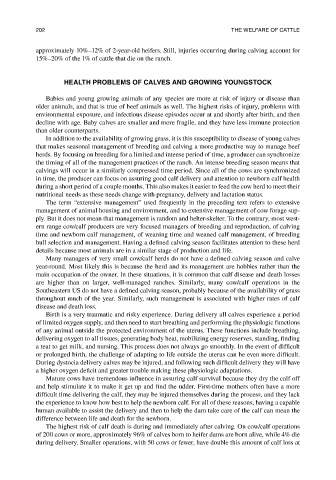Page 225 - The Welfare of Cattle
P. 225
202 the WeLfare of CattLe
approximately 10%–12% of 2-year-old heifers. Still, injuries occurring during calving account for
15%–20% of the 1% of cattle that die on the ranch.
heaLth PrOBLeMS OF CaLVeS aND GrOWING YOUNGStOCK
Babies and young growing animals of any species are more at risk of injury or disease than
older animals, and that is true of beef animals as well. The highest risks of injury, problems with
environmental exposure, and infectious disease episodes occur at and shortly after birth, and then
decline with age. Baby calves are smaller and more fragile, and they have less immune protection
than older counterparts.
In addition to the availability of growing grass, it is this susceptibility to disease of young calves
that makes seasonal management of breeding and calving a more productive way to manage beef
herds. By focusing on breeding for a limited and intense period of time, a producer can synchronize
the timing of all of the management practices of the ranch. An intense breeding season means that
calvings will occur in a similarly compressed time period. Since all of the cows are synchronized
in time, the producer can focus on assuring good calf delivery and attention to newborn calf health
during a short period of a couple months. This also makes it easier to feed the cow herd to meet their
nutritional needs as these needs change with pregnancy, delivery and lactation status.
The term “extensive management” used frequently in the preceding text refers to extensive
management of animal housing and environment, and to extensive management of cow forage sup-
ply. But it does not mean that management is random and helter-skelter. To the contrary, most west-
ern range cow/calf producers are very focused managers of breeding and reproduction, of calving
time and newborn calf management, of weaning time and weaned calf management, of breeding
bull selection and management. Having a defined calving season facilitates attention to these herd
details because most animals are in a similar stage of production and life.
Many managers of very small cow/calf herds do not have a defined calving season and calve
year-round. Most likely this is because the herd and its management are hobbies rather than the
main occupation of the owner. In these situations, it is common that calf disease and death losses
are higher than on larger, well-managed ranches. Similarly, many cow/calf operations in the
Southeastern US do not have a defined calving season, probably because of the availability of grass
throughout much of the year. Similarly, such management is associated with higher rates of calf
disease and death loss.
Birth is a very traumatic and risky experience. During delivery all calves experience a period
of limited oxygen supply, and then need to start breathing and performing the physiologic functions
of any animal outside the protected environment of the uterus. These functions include breathing,
delivering oxygen to all tissues, generating body heat, mobilizing energy reserves, standing, finding
a teat to get milk, and nursing. This process does not always go smoothly. In the event of difficult
or prolonged birth, the challenge of adapting to life outside the uterus can be even more difficult.
During dystocia delivery calves may be injured, and following such difficult delivery they will have
a higher oxygen deficit and greater trouble making these physiologic adaptations.
Mature cows have tremendous influence in assuring calf survival because they dry the calf off
and help stimulate it to make it get up and find the udder. First-time mothers often have a more
difficult time delivering the calf, they may be injured themselves during the process, and they lack
the experience to know how best to help the newborn calf. For all of these reasons, having a capable
human available to assist the delivery and then to help the dam take care of the calf can mean the
difference between life and death for the newborn.
The highest risk of calf death is during and immediately after calving. On cow/calf operations
of 200 cows or more, approximately 96% of calves born to heifer dams are born alive, while 4% die
during delivery. Smaller operations, with 50 cows or fewer, have double this amount of calf loss at

